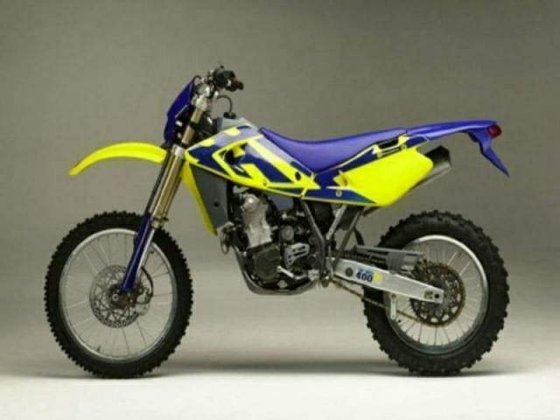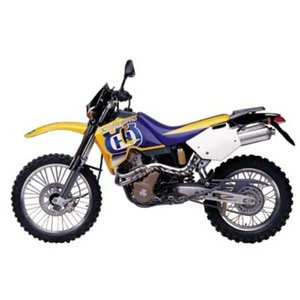Husqvarna TE 410 (1995–2000): The Swedish Enduro Workhorse Revisited

Introduction
The Husqvarna TE 410 is a motorcycle that demands respect from the moment you throw a leg over its slim, purposeful chassis. Built during an era when European enduro bikes were transitioning from raw, unforgiving machines to more refined trail partners, the TE 410 straddles both worlds with Swedish pragmatism. This review isn’t just a nostalgia trip—it’s a hands-on exploration of why this bike remains a cult favorite among vintage enduro enthusiasts and how it stacks up against modern expectations.
I spent a week with a meticulously maintained 1998 TE 410, tackling everything from rocky singletrack to open fire roads. Here’s why this bike still matters—and where it shows its age.
Engine Performance: Smooth Operator with a Wild Side
At the heart of the TE 410 lies a liquid-cooled, four-stroke single displacing 399–414cc (depending on model year), delivering between 34–44 HP. Numbers alone don’t tell the story. This engine is a study in contradictions: civilized enough to chug up technical climbs without stalling, yet willing to scream to a 9,500 RPM crescendo when you wring its neck.
Key Takeaways:
- Power Delivery: The 36mm Dell’Orto carburetor (pre-2000 models) provides crisp throttle response. Torque peaks at 40.6 Nm (30 lb-ft) around 5,150 RPM, making it a tractor in low-speed scenarios. By 7,000 RPM, it transforms into a rev-happy trail burner.
- Gearbox: The 6-speed transmission is a revelation. First gear crawls through boulder fields, while sixth lets you cruise at 160 km/h (100 mph)—though you’ll feel every gust of wind at those speeds.
- Starting Rituals: Early models are kickstart-only, with a left-side lever that’s quirky but manageable. The 2000 TE 410e added electric start, a godsend after stalling mid-hill.
On the Trail:
The TE 410 thrives in ambiguity. On tight New England singletrack, it lugs like a trials bike. Open up on a desert wash, and it’ll hold pace with modern 450s—until the suspension reminds you it’s 25 years old. The exhaust note is muted by today’s standards, but that’s a plus for stealthy trail access.
Handling & Suspension: Confidence Meets Compromise

Husqvarna’s chrome-moly frame houses a suspension package that was premium in its day. The 45mm Marzocchi inverted forks offer 285mm (11.2") of travel, while the Sachs rear shock provides 320mm (12.6") of wheel movement. Adjustability is basic compared to modern WP or Öhlins setups, but the tuning philosophy shines.
Front End:
The Marzocchis are plush over roots and small rocks, resisting dive under braking. Push hard into whoops, and they’ll wallow—a quick adjustment to compression damping (via screwdriver and patience) firms things up. Steering is deliberate, not twitchy, thanks to the 1,495mm (58.8") wheelbase.
Rear Suspension:
Ben Grabham wasn’t wrong—the 2000 model’s revised Sachs shock is a leap forward. Earlier versions tend to kick on square-edged hits, but the ’00 unit soaks up everything from log crossings to motocross-style jumps. Preload adjustment is mandatory for riders over 80kg (176 lbs).
Brakes:
Single 260mm front and 220mm rear discs lack bite compared to modern radially mounted setups. They’re progressive, though, which prevents accidental endos on slippery descents. Swap pads to sintered units for noticeable improvement.
Ergonomics & Comfort: Built for Vikings (or Not?)
At 116–125kg (255–275 lbs) dry, the TE 410 feels light by today’s standards—until you realize most of that weight sits high. The 885mm (34.8") seat height is daunting for shorter riders, though a 840mm (33") option exists on some models.
Rider Triangle:
- Bars: Narrow by modern standards at 780mm. Taller riders will want a 800mm+ handlebar swap.
- Pegs: Rubber-coated pegs offer decent grip but lack the sharp teeth of contemporary enduro pegs.
- Tank: The 9.1L (2.4 gal) fuel capacity limits range to about 175km (110 miles)—plan accordingly.
Long-Haul Comfort:
This isn’t a dual-sport. The seat is firm, vibration is noticeable at highway speeds, and wind protection is nonexistent. That said, it’s miles ahead of ’90s MX bikes for endurance events.
Competition: How the TE 410 Stood Its Ground
In the late ’90s enduro scene, the TE 410 faced fierce rivals:
- KTM 400 EXC (1998–2000):
- Lighter (112kg/247 lbs) with sharper handling.
- Less linear power delivery—harsher hit off idle.
-
Air-cooled until 2003; the Husky’s liquid cooling won in technical terrain.
-
Honda XR400R (1996–2004):
- Bulletproof reliability but 12kg (26 lbs) heavier.
- Softer suspension, lower seat height (910mm/35.8").
-
No sixth gear—less versatile for mixed terrain.
-
Yamaha WR400F (1998–2000):
- First-gen WR had explosive power but finicky carburetion.
-
Steel frame flexed under hard loads vs. Husky’s CrMo rigidity.
-
Husaberg FE 400 (1994–1999):
- Similar Swedish DNA but plagued with reliability issues.
- TE 410’s wet sump lubrication was simpler for trailside maintenance.
Verdict: The TE 410 carved a niche as the “thinking rider’s enduro.” It traded outright aggression for usability—a precursor to today’s trail-optimized bikes like the Beta 430 RR-S.
Maintenance: Keeping the Legend Alive
Owning a TE 410 today isn’t just about riding—it’s about stewardship. Here’s how to keep it thriving:
- Oil Changes:
- Every 15 engine hours or 500km (310 miles).
-
Use 10W-50 full synthetic. The wet clutch hates energy-conserving oils.
-
Air Filter:
-
Clean every ride if you’re in dust. The stock foam filter needs oiling—skip the cheap spray-on stuff.
-
Carburetor TLC:
-
Dell’Orto carbs gum up if left unused. A 36mm Mikuni TM swap (from MOTOPARTS.store) adds reliability.
-
Suspension Refresh:
- Replace fork seals every 2 years. Upgrade to SKF seals for longevity.
-
Sachs shock rebuild kits are still available—swap the bladder annually.
-
Brake Upgrades:
-
Stainless steel brake lines (MOTOPARTS P/N: SS-BRK-410) improve feel.
-
Chain & Sprockets:
- The 520 chain stretches quickly. A DID VT2 Enduro chain adds 30% lifespan.
Pro Tip: The left-side kickstarter’s splines wear over time. Apply anti-seize during reassembly to prevent stripping.
Conclusion: A Timeless Trail Partner
The Husqvarna TE 410 isn’t perfect by 2024 standards. It vibrates, the seat is punishing, and parts hunting can be a chore. But ride one back-to-back with a modern enduro bike, and you’ll rediscover the joy of simplicity. There’s no traction control, ride modes, or Bluetooth here—just a machine that demands skill and rewards it with unadulterated connection to the trail.
For MOTOPARTS.store riders, this Husky represents a golden opportunity. Upgrade its suspension, tweak the ergonomics, and you’ve got a vintage racer that’ll humble newer bikes in technical terrain—all while turning heads at the trailhead.
Ready to revive your TE 410? Explore our curated selection of Husqvarna-specific upgrades at MOTOPARTS.store—where legacy meets performance.



















